The 9/11 Memorial Museum: Memorialization or Mind Control?
Part 2 - Footprint Paneling and Size, Beams from the Impact Site, the Memorial Hall, the Repository, the Survivors' Staircase, In Memoriam, the Rest of the South Tower Footprint, Ladder 3, the Antenna
Introduction
In Part 1 of this series, I guided readers below ground as we began our critical exploration of the 9/11 Memorial Museum. As we descended into an underworld marked by themes of shock and trauma, we found ourselves in a highly artificial space in which nothing is quite as it seems.
In what follows, our journey continues into the depths of the museum, where we finally encounter some damaged relics from the original World Trade Center site and find more evidence of perceptual manipulation in the design of the museum.
The Foamed Aluminum Paneling
It is easy to assume, as I first did, that what Robert Bevan calls the “shimmering volumes clad in foamed aluminium panels” (seen below on the right) are the outer edges of the below-ground memorial pools.
Source: 911memorial.org
That is not the case, however. According to the official 9/11 Memorial site, the memorial pools descend 30 feet into a square basin, then a further 20 feet via the lower catch basins. Therefore, the foamed aluminum paneling conceals a large space around the lower catch basins — further evidence of artifice.
According to Davis Brody Bond, the firm which designed the museum, the distance between the lower catch basins and the exhibit galleries below is “so slim [that] additional spray insulation was used between layers to ensure no thermal transfer would occur.”
Therefore, if the memorial pools are 50 feet deep, we would expect to see a further 20 feet to the bedrock, given that the “bathtub” is said to be 70 feet deep (although a reliable exact specification is difficult to find).
Yet, the distance between the bottom of the paneling and the ground is no more than 10-12 feet, judging by the height of the people beneath it. 1-2 feet of this can be accounted for by the depth of the concrete floor. Therefore, the bottom of the paneling is not at the same level as the bottom of the memorial pools.
These may seem like pedantic considerations, but the point is that we are dealing here with a deceptive space. The one thing that visitors can know with certainty as they descend below ground is that the space will contain the two giant footprints of the memorial pools. Yet, the foamed aluminum paneling acts as a giant curtain concealing the contours of the pools.
This has a disorienting effect. For example, where exactly is the bottom of the first 30-foot drop in each memorial pool? The main floors of the pools are clearly visible from above ground, but inside the museum it is hard to gauge what level they would be at, and there are no markers to help.
Although it is possible to orientate oneself in terms of where the North and South Towers once stood, that is the only feature of the museum, once one has descended below ground, that allows for any kind of connection to the above ground world. Otherwise, visitors are completely cut off from a reality that is known and familiar.
Disorienting victims and placing them in a strange and unfamiliar environment is a tactic used by interrogators on prisoners and is again consistent with mind control techniques (see Chapter 2 of my book).
A memorial museum should embody a commitment to accuracy, transparency, and authenticity. Instead, visitors find themselves in a misleading, subterranean space whose deceptive features create a false reality conducive to manipulating their perception.
The Area of the Footprints
Not only does the foamed aluminum cladding bear no relation to the depth of the memorial pools, it also bears no relation to their area.
The pool containment structures measure 211 feet and 10 inches across, which is the same as the footprints of the original buildings.
However, as a New York Times article from 2005 notes, the memorial pools are only 176 feet across, so are 31% smaller in area than the original footprints (within which they are centered), and “official descriptions do not emphasize this fact.”
People looking into the memorial pools at ground level assume they are looking at the footprints of the Twin Towers, without realizing that they are standing within the footprints.
This information is hard to find unless one goes looking for it. Why mislead people in this way?
Given the design of the above ground memorial, there is an important difference between whether one is standing within the area where the Twin Towers “fell,” or outside it. Respect for the victims is shown by not transgressing into what has been demarcated as hallowed ground. There is also a certain emotional security in knowing that one has not set foot in the area where mass loss of life took place.
Therefore, it would probably shock most visitors who have stood around the edges of the memorial pools (as it did me) to discover that they were standing inside the very area where so many lives were lost.
Had Daniel Libeskind’s concept of the two giant voids in the “masterplan” for the WTC redesign (see Part 1) not been used, visitors’ relationship to the space involved would have been different. What is shocking is not that visitors to the memorial pools set foot within the footprints of the Twin Towers per se, but that they have fundamentally been lied to.
Dishonesty seems the worst of all foundations on which to built a memorial site, and deception is consistent with psychological abuse and manipulation.
Beams From The Impact Site
Continuing our journey along the ramp that brings visitors to the main part of the museum, past the south side of the North Tower memorial pool, we encounter some suspended beams said to have been at the center of the impact site of the first “plane” on WTC1. I put “plane” in inverted commas, because there are disagreements concerning whether or not commercial airliners hit the towers, and I remain open-minded.
The encounter with the beams — the first hard evidence of destruction seen up close by visitors — follows the chronology of September 11, 2001. It also draws our attention downwards, in keeping the museum’s theme of descent.
Below is what the North Tower looked like after it was hit. Edna Cintron can be seen waving at the bottom where the left engine would have impacted. She is evidently unaffected by temperatures said to have been hot enough to soften steel.
Source: Reddit
Many questions have been asked regarding whether the fuselage (often likened to a giant coke can) could really have pierced the thick steel columns, or whether the flimsy wing tips could have knocked out pieces of the aluminum cladding.
Welded Steel lattices joined together during construction. Source: Fire Engineering
I do not have the answers, but I do wonder whether, rather than the steel columns being destroyed or sliced apart, they came apart at the points where they were first attached to one another, and were carried into the building?
Source: Building the World Trade Center 1983
Much of the aluminum cladding appears to have come away along horizontal lines where different pieces of cladding presumably connected with one another. It is possible to imagine pieces of cladding being dislodged by the force of the impact.
Given that conflicting theories have been proposed regarding whatever it was that hit each tower, it would have been helpful to have seen an official explanation of the physics involved in the creation of the gashes in the North and South Towers.
The museum makes no attempt to enlighten visitors in that respect, however. All that visitors need to know, apparently, is that Islamist hijackers flew commercial airliners into the buildings.
The Memorial Hall
Having moved past the twisted beams from the impact site, visitors catch a glimpse of the striking tribute to the victims on the wall of the Memorial Hall, which is located between the footprints of the North and South Towers.
Source: 911memorial.org
This is an art installation by Spencer Finch titled Trying to Remember the Color of the Sky on That September Morning. The 2,983 blue paper panels represent the victims of the 2001 attacks (not just in New York), plus the six people who died in the 1993 World Trade Center attack. They do not include the 19 alleged hijackers.
September 11, 2001, was memorable for its clear blue skies over Manhattan, which contrasted markedly with the extensive war games exercises taking place elsewhere over North America, as well as the darkness of what took place that day. The bright wall of blue in the Memorial Hall seems similarly incongruous vis-à-vis the rest of the museum.
The sky is visible in many videos and photographs taken on September 11, 2001. Therefore, the idea of “trying to remember the color of the sky,” and the different shades of blue used on the paper panels, seems odd. Why not just check? The purpose of a memorial museum should be to record events accurately wherever possible, not to “try” to remember.
Granted, trauma is often associated with memory loss, but in this specific case, i.e., the color of the sky on “9/11”, we are dealing with something empirically verifiable. The idea of “trying to remember,” in contrast, opens the door to misremembering and getting things wrong, possibly on purpose.
Meanwhile, the Virgil quote is problematic, because, in its original context, it celebrates two lover-warriors (Nisus and Euryalus) who “sacrificed their lives in the interest of the future Roman state,” according to John F. Makowski, associate professor of classical studies at Loyola University.
The original lines in the Aeneid read as follows:
Fortunate pair! If anything can come of my verses,
no day shall erase you ever from the memory of time,
so long as the house of Aeneas mounts the Capitol’s fixed rock
and the Roman Father ever holds his power.
Here, remembering the dead is tied to the endurance of the Roman state.
Many critics have pointed out that the deaths of Nisus and Euryalus have nothing whatsoever in common with the deaths of 2,983 victims on September 11, 2001. By tacitly making remembrance of those deaths conditional upon the endurance of the state, we are looking, not so much at a tribute to those who died, as a monument to state power.
Putting the art installation and the Virgil quote together, as the museum has done, suggests that remembering what happened on September 11, 2001, is to be a function of state power.
The Repository
Behind the massive concrete wall on which the installation is placed is a repository allegedly containing thousands of body parts from almost 40% of victims not identified by their remains.
The concrete wall is a fitting symbol of state power: only staff of the Office of Chief Medical Examiner of the City of New York are allowed behind it. Even victims’ family members are not allowed in. Instead, they can access a private space next to the repository, known as the Reflection Room.
Source: archdaily.com
Some victims’ families did not want the remains of their loved ones to be entombed without identification. The counter-argument, used by the museum, is that the repository is not a mausoleum but, rather, a holding facility while scientific advances promise improved means of DNA identification.
Having caught a first glimpse of Trying to Remember the Color of the Sky on That September Morning, I made my way to a viewing platform at the end of the ramp. There, I was amazed, and shocked, to hear a museum guide tell visitors that, because the towers “pancaked” down upon themselves, the remains of (all?) the victims inside them had been discovered within the debris and were awaiting identification.
Below is how the Twin Towers were destroyed, as captured from a NYPD helicopter:
As Dr. Judy Wood has argued, they and their contents were mostly turned to dust in mid air, implying molecular dissociation, and anything which landed was spread over a large area. For instance, human bone fragments were recovered from the roof of the former 41-story Deutsche Bank building across the street (at 130 Liberty Street) in 2006.
Therefore, is it true that the remains of 1,106 victims yet to be identified, or most them, were discovered, or is this an artifice to conceal the fact that a very large number of people simply vanished without trace? The fact that museum staff are propagating the “pancaking” myth in support of the former provides reasonable grounds for suspicion.
The “Survivors’ Staircase”
From the end of the ramp, turning right from the viewing platform, visitors descend once again, either side of the “Survivor’s Staircase.”
Source: Wikipedia
Below is a close-up of the sign at the bottom of the stairs.
Note that the description of the “Vesey Street stairs” is not linked in any way to “survivors,” and that “Survivors’ Stairs” is placed in inverted commas even on the official signage.
According to Wikipedia, the stairs were an escape route for hundreds of evacuees from WTC5.
Yet, WTC5 suffered nowhere near the same level of damage as the other WTC buildings. The bottom three floors of nine were undamaged. The fires on floors 5-9, whose cause remains unclear, peaked in intensity around 1pm, several hours after the Twin Towers were destroyed (at 9:59am and 10:30am, respectively). By that time, the WTC site had been evacuated. No one was killed in WTC5, by falling debris or anything else.
Therefore, did the stairs really facilitate “survival”? Would anyone have died had they not existed? Or are they are yet another artifice?
In Memoriam
The descent alongside the “Survivors’ Staircase” takes visitors to quasi-bedrock level for the first time, spilling them out next to the South Tower footprint.
Beneath the South Tower memorial pool is the In Memoriam Exhibition, designed by Thinc Design. It is the first space that visitors come to where photography is forbidden.
I did not have a problem with the prohibition of photography there. Visitors walk into a somber environment, with seating around the edges, where images of the deceased are projected onto the walls, one at a time, with accompanying narration. The silence was impeccably observed when I was there.
Source: thincdesign.com
The floor of the room is transparent — a rare moment of authenticity, perhaps? Then again, it is unclear what exactly lies beneath the glass.
Surrounding the room is an outer section where the faces of almost every victim are displayed. Some of their personal possessions are also displayed.
A designer’s rendering of the portraits to the almost 3,000 victims. Source: Paul Mullins
This is the opposite of a tomb to the unknown solider. Every effort was made to find images of all who perished. This proved difficult in the case of seven migrants, but apparently only two of them remain without a portrait.
Yet, In Memoriam, like the rest of the museum, is not quite what it seems. When I entered that square space, and was sitting solemnly, I assumed I was in the center of the South Tower footprint.
Only later did I learn that the inner and outer layers of In Memoriam are crammed into a relatively small area of the South Tower footprint, because of the PATH train platforms.
Source: archdaily.com
The fact that over half the available space beneath the South Tower is not part of the museum is barely advertised to visitors. In fact, it is only revealed once, on a sign next to the North Tower footprint that is, as one critic noted, “tucked into an area that is not traversed by many people, and it is not included in the Museum Map.”
Source: Archidose
Again, this smacks of intent to conceal. After all, if this is “hallowed ground” (a phrase that is often used), where the deaths of almost 3,000 people in a national tragedy (as well as the six victims of the February 26, 1993, attack) are remembered, then it seems highly inappropriate to drive trains straight through it.
There was plenty of opportunity to redirect the PATH lines during reconstruction, but commercial considerations evidently trumped any memorial or sacralizing function. Obviously, this does not send out a good message, so it is not mentioned.
While the train lines get over half the area at the bottom of the South Tower footprint, In Memoriam is comparatively tiny.
Much of the remaining space is taken up by offices and educational rooms. In that banal context, remembering the dead does not seem so important after all.
The Rest of the South Tower Footprint
Visitors leave In Memoriam through the same door they went in and therefore emerge facing the Memorial Hall and the North Tower footprint.
Having descended the “Survivors’ Staircase,” the route around the museum is, for the first time since entering the pavilion, no longer prescribed. Once in the bowels of the museum, visitors are free to wander where they like.
The obvious temptation is to head over to the North Tower footprint, as I did. In the process, I neglected to explore the “Tribute Walk” and the rest of the area in the South Tower footprint. I imagine I am not the only person to have done this.
The “Tribute Walk.” Source: Archidose
At the end of the “Tribute Walk” is a remarkable piece of steel. Which part of the Twin Towers is it from, and what caused it to distort in this way?
Source: Cumming Group
The fact that it is easy to miss such important artefacts seems like a design flaw to me, as once one has gone round the rest of the museum, the Tribute Walk is no longer visible and becomes easy to neglect.
Even if one does go along the “Tribute Walk,” then, judging by the above diagram, one has to go all the way around the education rooms as well to reach the “Rebirth at Ground Zero” film exhibition. To say it is tucked away would be an understatement.
“Rebirth” sounds positive and uplifting, so why make the film exhibition difficult to find? Or, is the point to keep visitors submerged in darkness and negativity to the maximum extent possible?
Ladder 3
Readers may have noticed that we have explored approximately half of the 9/11 Memorial Museum so far, but have barely seen any primary empirical evidence relating to what took place on September 11, 2001.
The museum’s director, Alice Greenwald, would probably argue that this is about “emotional safety,” and that the museum’s content gets progressively more challenging the further one goes, such that one can exit at any time if it all gets too much.
The flip side of this approach, however, is that anyone serious about learning what happened to the Twin Towers, and who wants to see the evidence with their own eyes, is kept waiting a long time.
Eventually, I reached the Center Passage of the museum and found Ladder 3 in front of me.
Of all the vehicles destroyed on September 11, 2001, Ladder 3 is among the most arresting, because of its missing cab and engine and the damage to its ladder.
Below is a better lit image from the museum website.
Source: 911memorial.org
Members of FDNY Ladder Company 3 asked to be deployed to the World Trade Center, many of them having just finished an overnight shift. Eleven of them entered the North Tower and were last seen on the 35th floor before the building was destroyed.
As I reached Ladder 3, a gentleman whom I understood to be either the brother or former colleague of one of the deceased firefighters had begun a talk. It was a very moving tribute to the firefighters.
After the talk finished, I thanked the gentleman and asked him how exactly the vehicle in front of us had sustained such extraordinary damage. He replied that the rear half of the vehicle had been underneath a bridge, so, unlike the front half, had been sheltered from falling debris.
Photographs from after the destruction of the Twin Towers, however, suggest that was not quite right. Ladder 3 was parked on West Street near Vesey Street and was destroyed next to the North Bridge, but the rear of the vehicle does not appear to have been under the bridge (which collapsed).
Source: Facebook
Source: Instagram
It is not entirely clear from these photographs how exactly the damage to Ladder 3 was sustained, but the large steel lattice from WTC1 pointing toward what used to be the cab area may offer a clue.
For reference, here is what Ladder 3 looked like before it was destroyed:
Source: Facebook
And after:
Source: YouTube
The Antenna
The museum’s Central Passage also contains a fragment of the radio and television antenna from the North Tower.
Source: walkaboutny.com
The 362-foot antenna was added to the North Tower in 1979 and began transmitting television signals in 1980. It was upgraded to accommodate digital television broadcasts in 1999.
Source: Facebook
When the North Tower was struck on September 11, 2001, eight of New York’s television stations were unable to broadcast for at least a day, although they could still reach viewers via cable and satellite. Only one of New York’s major stations, WCBS-TV, was able to maintain live transmission, by switching to its back-up transmitter at the Empire State Building.
One consequence of this was that live coverage of the Twin Towers was dominated by a small number of major channels, including ABC, CBS, CNN, and Fox. Their footage was shown globally, influencing the perception of the billion or more people watching live.
It was filmed from a distance: there are no ground-level or close-up videos in the mainstream coverage. For that, we rely on amateur footage, much of which was bought up on the day by the big channels and never aired.
Therefore, it is worth asking: was the functionality of the antenna on the North Tower knocked out deliberately at the beginning of the attacks, so that a handful of media behemoths could steer public perception on a global scale? Of course, the museum does not ask such questions.
Another section of the antenna ended up in the Newseum in Washington, D.C., which, however, closed in 2019 and placed the section into storage.
Source: YouTube
One thing that puzzles me about the antenna is how any of it survived intact. For instance, the video below shows the antenna dropping into the zone where the top 30 or so stories were turned to dust before hitting the ground.
Not only was the antenna not completely dustified, but it also fell 110 stories before hitting the ground. How, then, did the section of it in the 9/11 Memorial Museum manage to survive in such relatively good condition?
Finally, it would be remiss not to mention the new antenna on top of One World Trade Center.
Source: YouTube
Because it is so high up, no one ever really sees the bottom of it. But I would be interested to know why there are three circular rings, one above the other.
I would also be interested to know whether or not there is any symbolic significance in the design of the new antenna. For example, there appears to be the beginnings of a cross within a circle, but the cross is not complete. Or, we might recognize a diamond within a circle within a square. I am not currently aware of any symbolic significance, however.
Source: Google Maps
Conclusion
Our continued journey into the dark depths of the 9/11 Memorial Museum has proven just as unsettling as the initial stage of the descent, if not more so.
What, if anything, are the foamed aluminum panels hiding? Why are visitors to the memorial pools not told that they standing in the space of the Twin Towers’ footprints, rather than being deceived that they are looking at those footprints? Displaying some twisted beams from the “plane” impact site on WTC1 goes nowhere to resolving disputes about what exactly hit the Twin Towers. Encoded in the Memorial Hall installation is the problematic idea that remembering the dead is a function of state power. The fact that 1,106 victims are still unidentified is particularly disturbing: for how many of them are traces available in the Repository, and how many vanished without trace? Did the “Survivor’s Staircase” save any lives? On supposedly hallowed ground, is preserving the position of train lines more important than remembering the dead? Why is the only positive-sounding part of the museum (“Rebirth”) the hardest to find? What exactly happened to the Ladder 3 fire truck, and how did part of the antenna manage to survive relatively intact?
There are many uncomfortable and unanswered questions here, as well as further evidence of deception and inappropriate subliminal messaging. Certainly, visitors should not enter the museum expecting to receive any kind of enlightenment regarding what really took place on September 11, 2001.
In the final part of this series, I will guide readers around the North Tower section of the museum — in more ways than one.

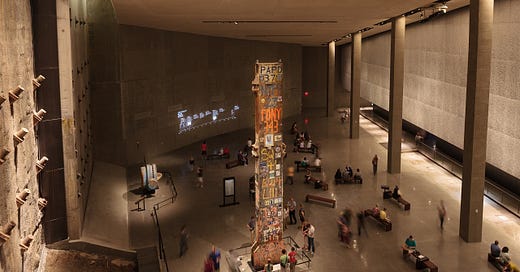


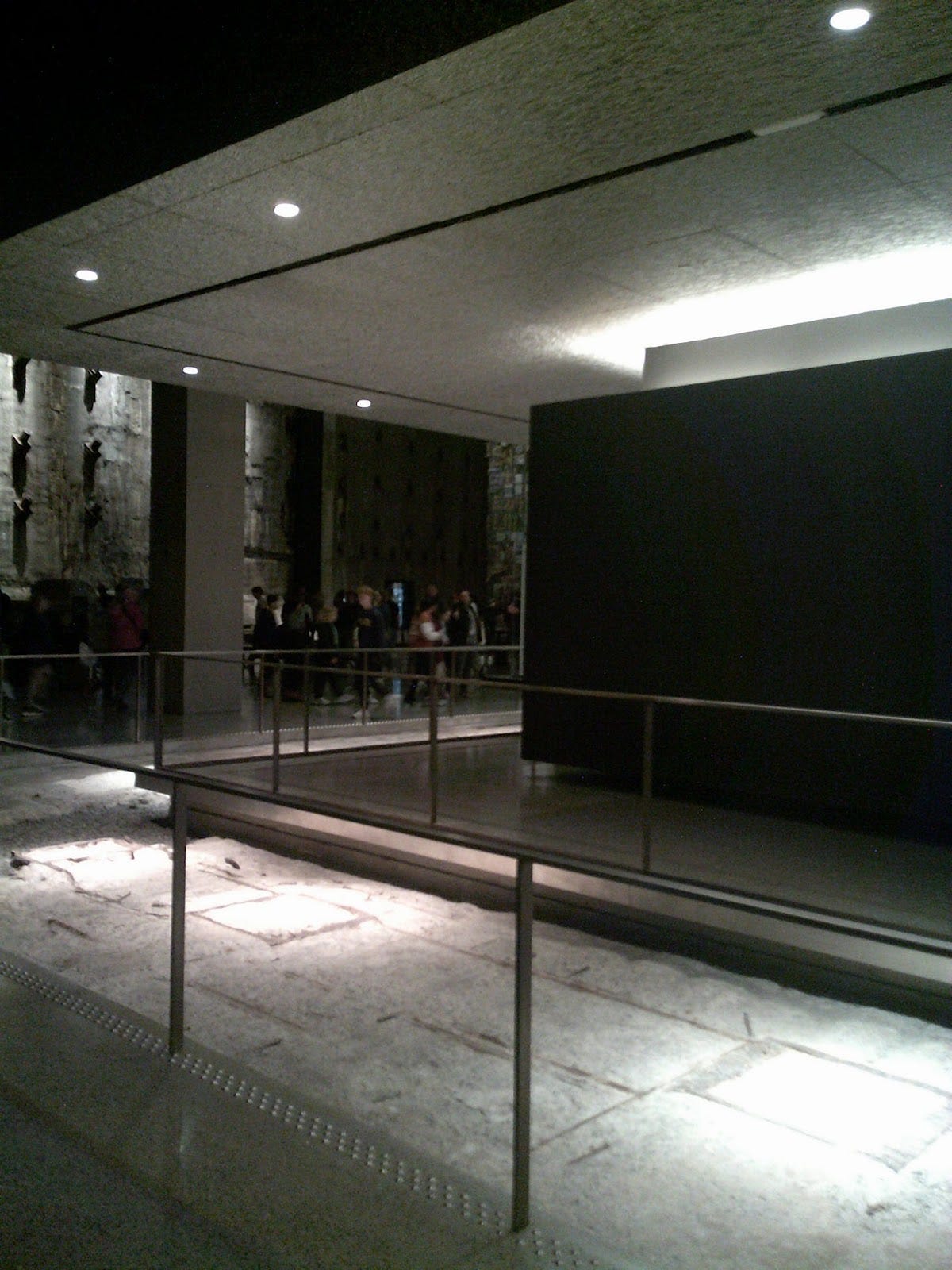

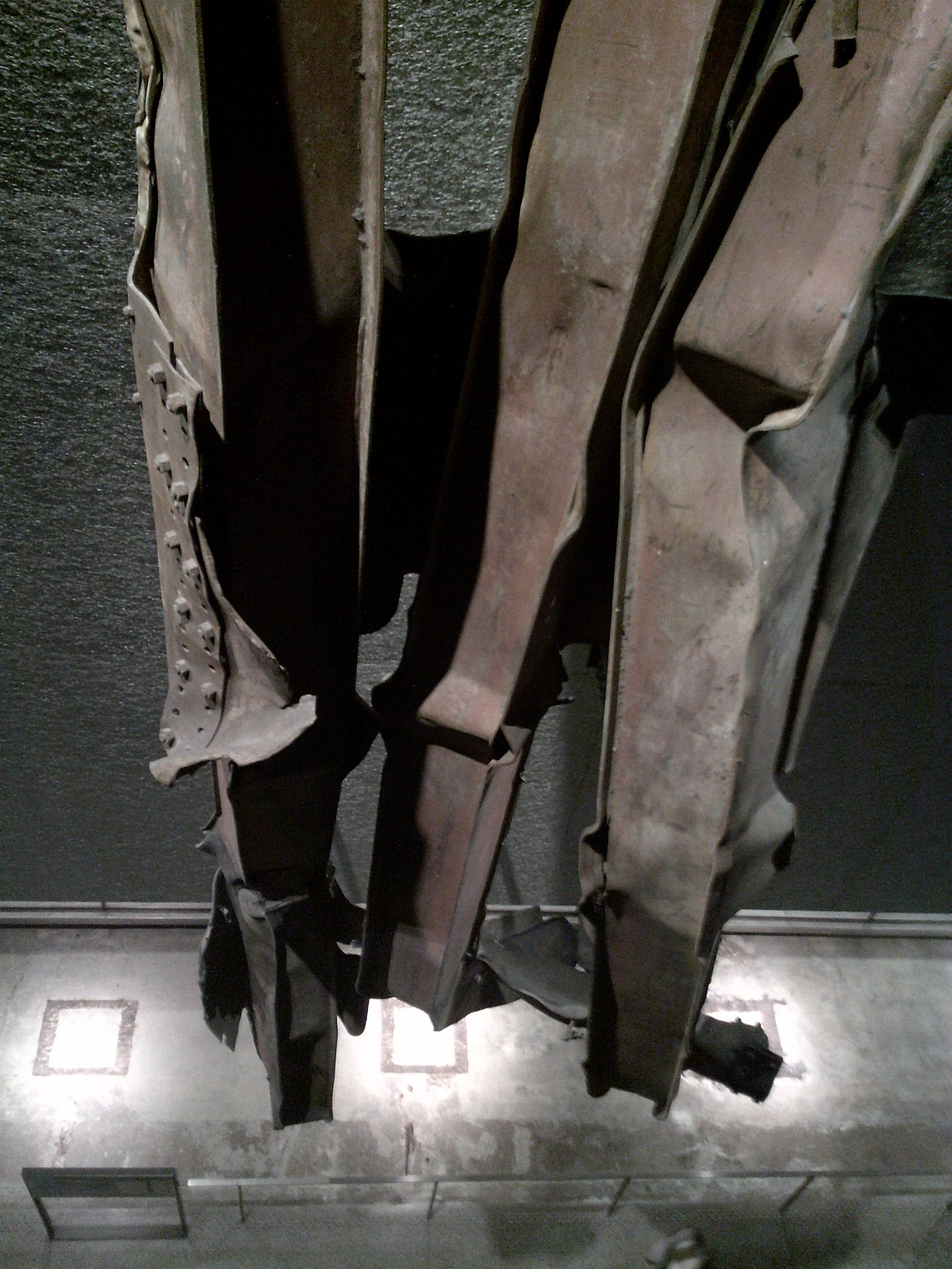

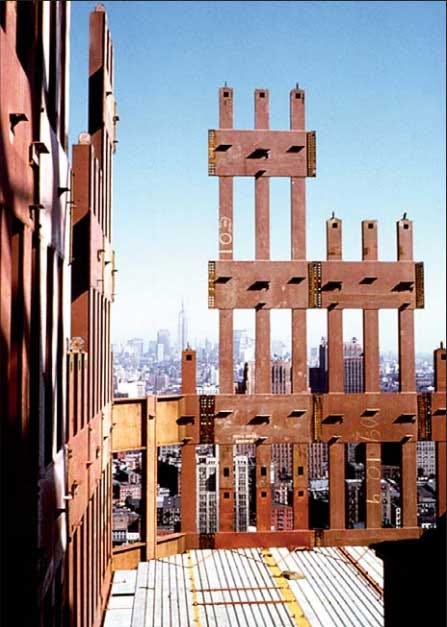

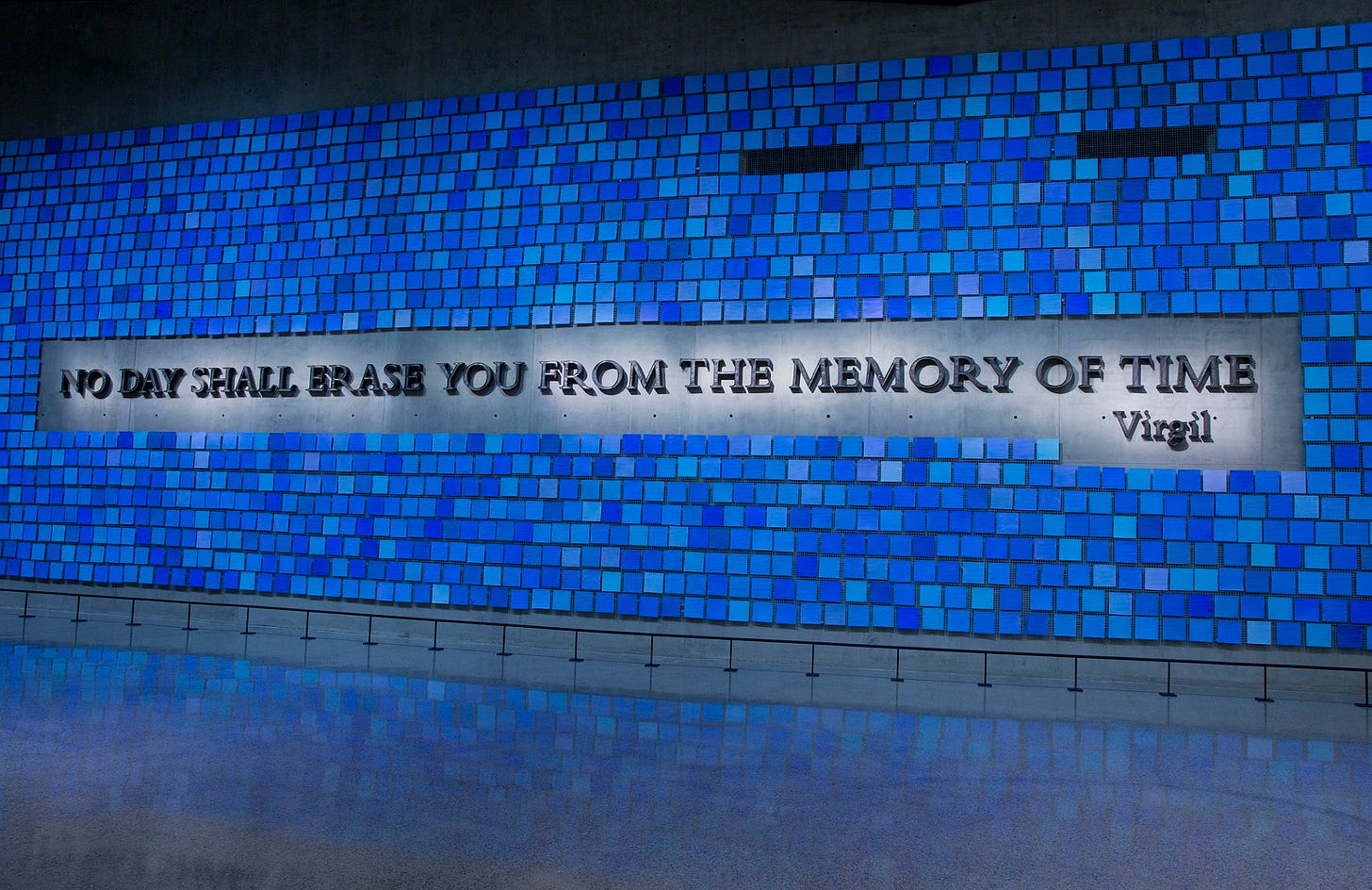





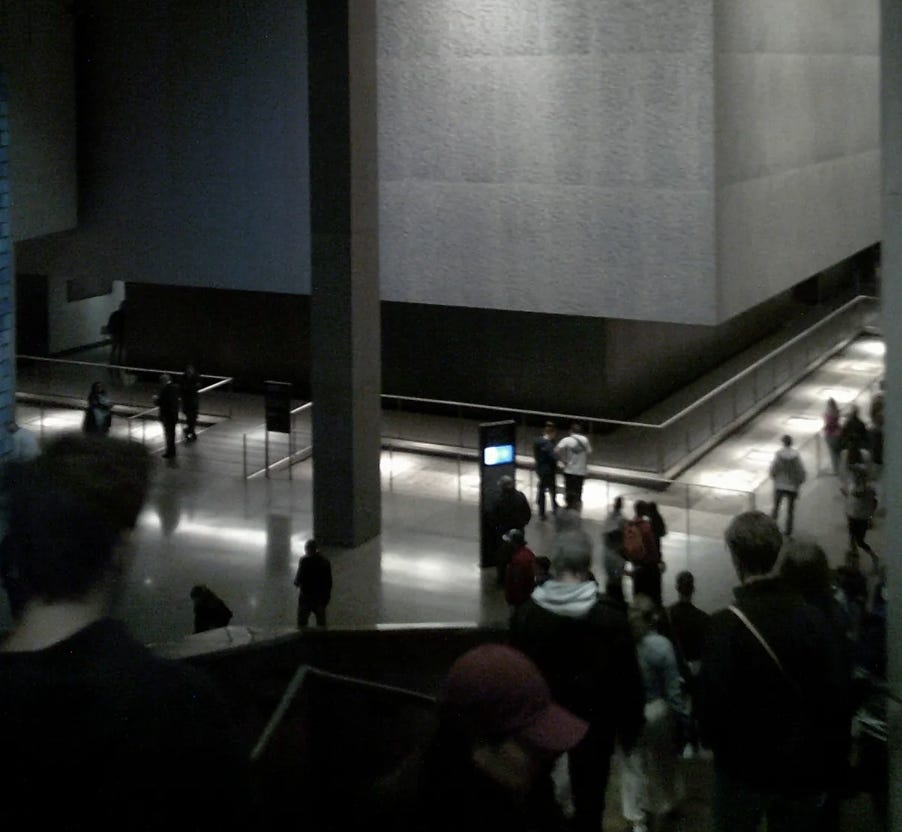
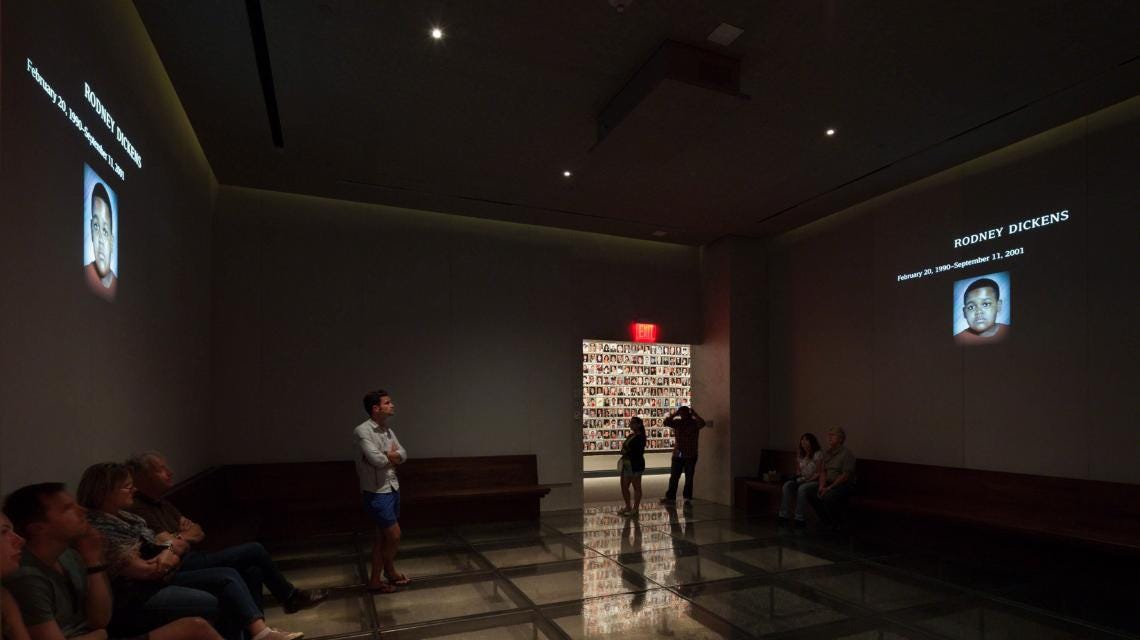
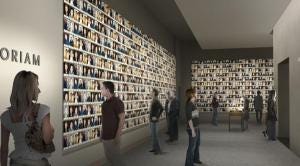

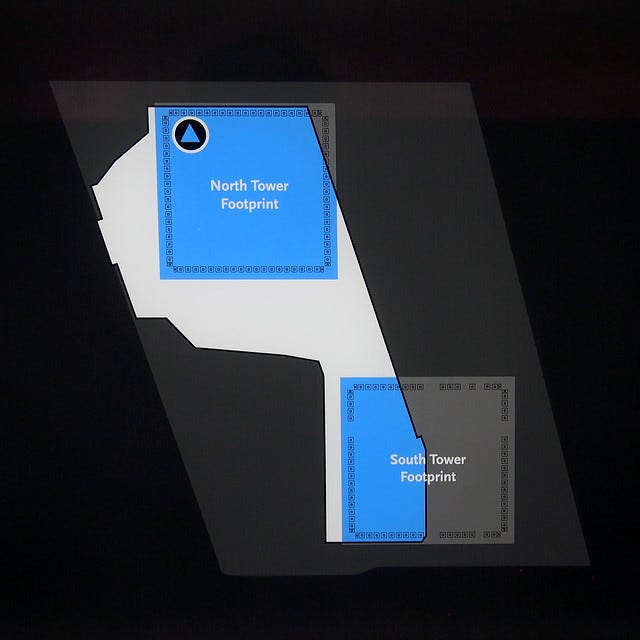
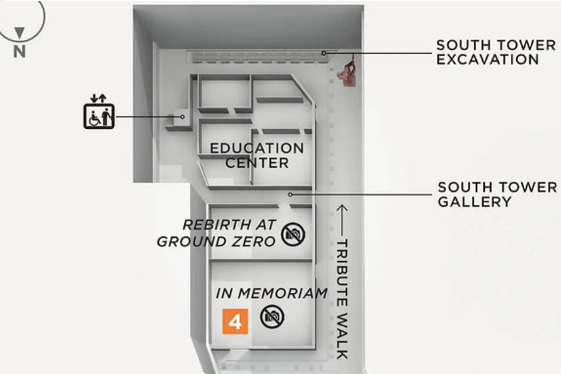
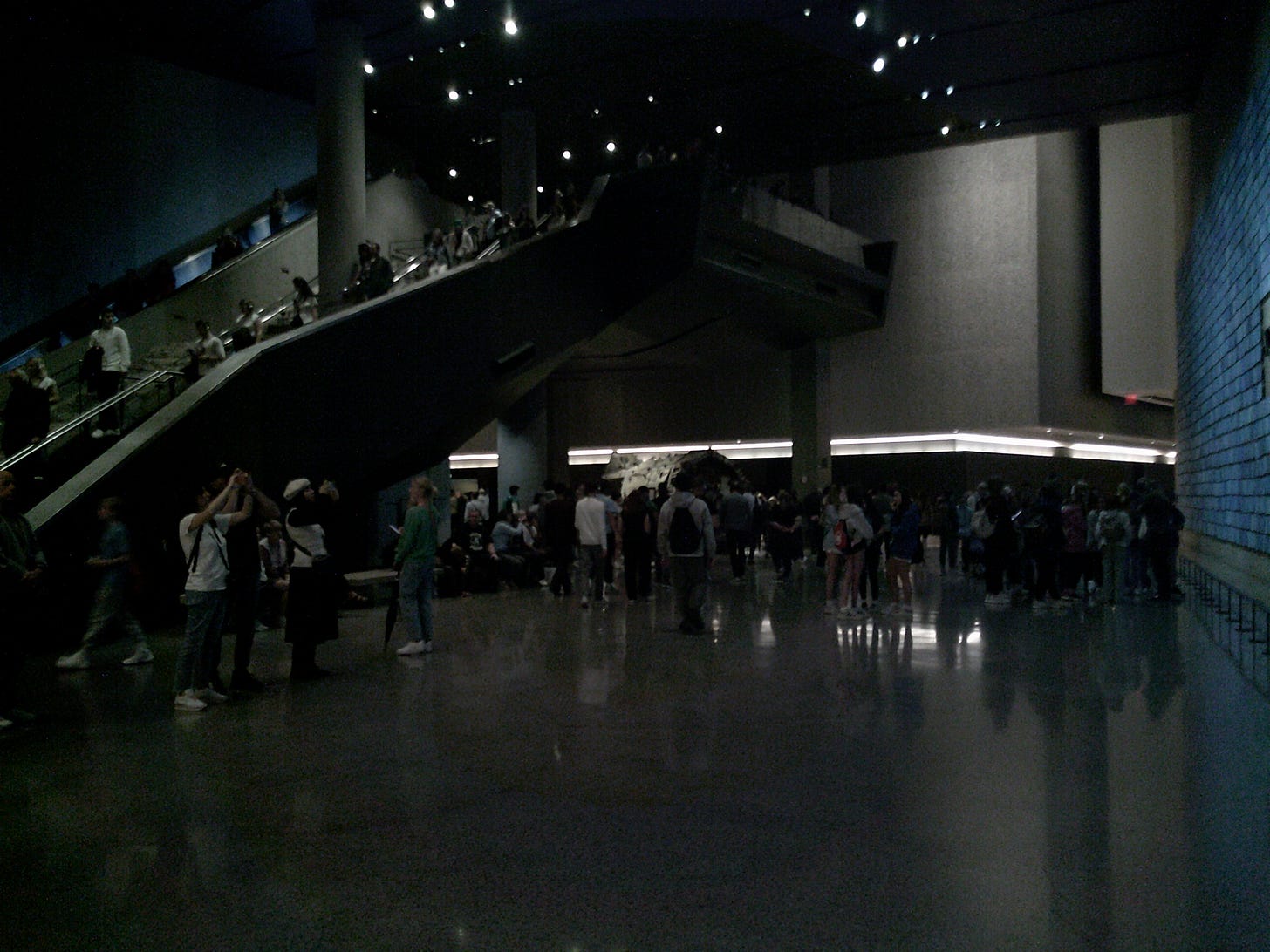

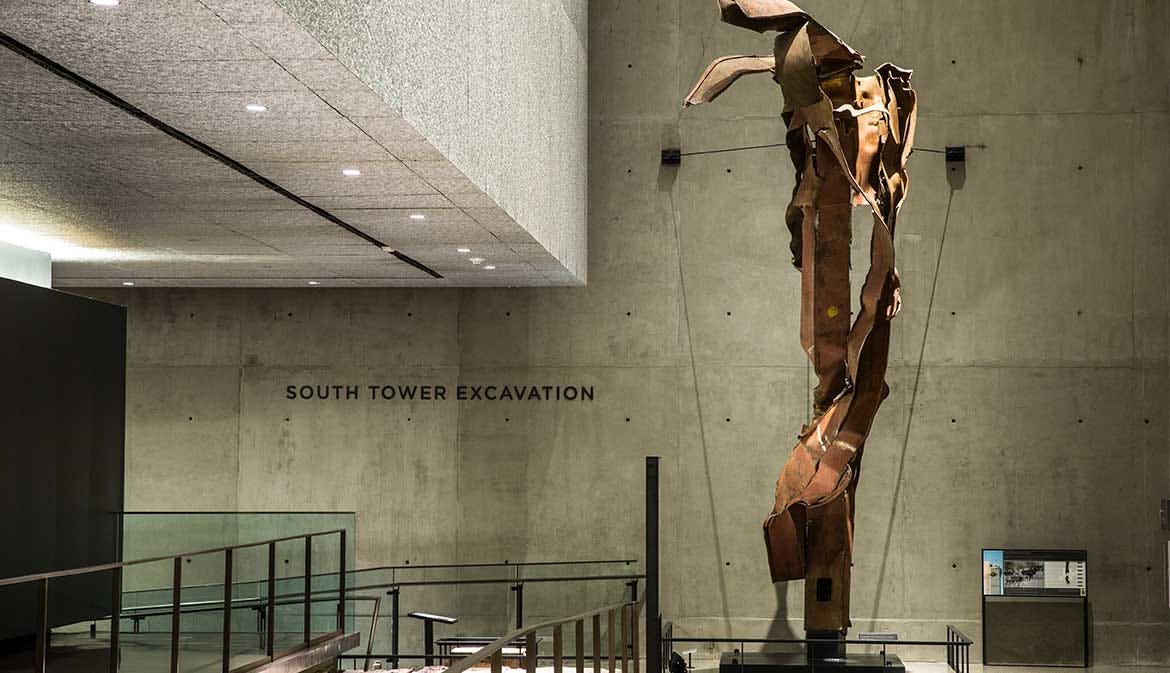

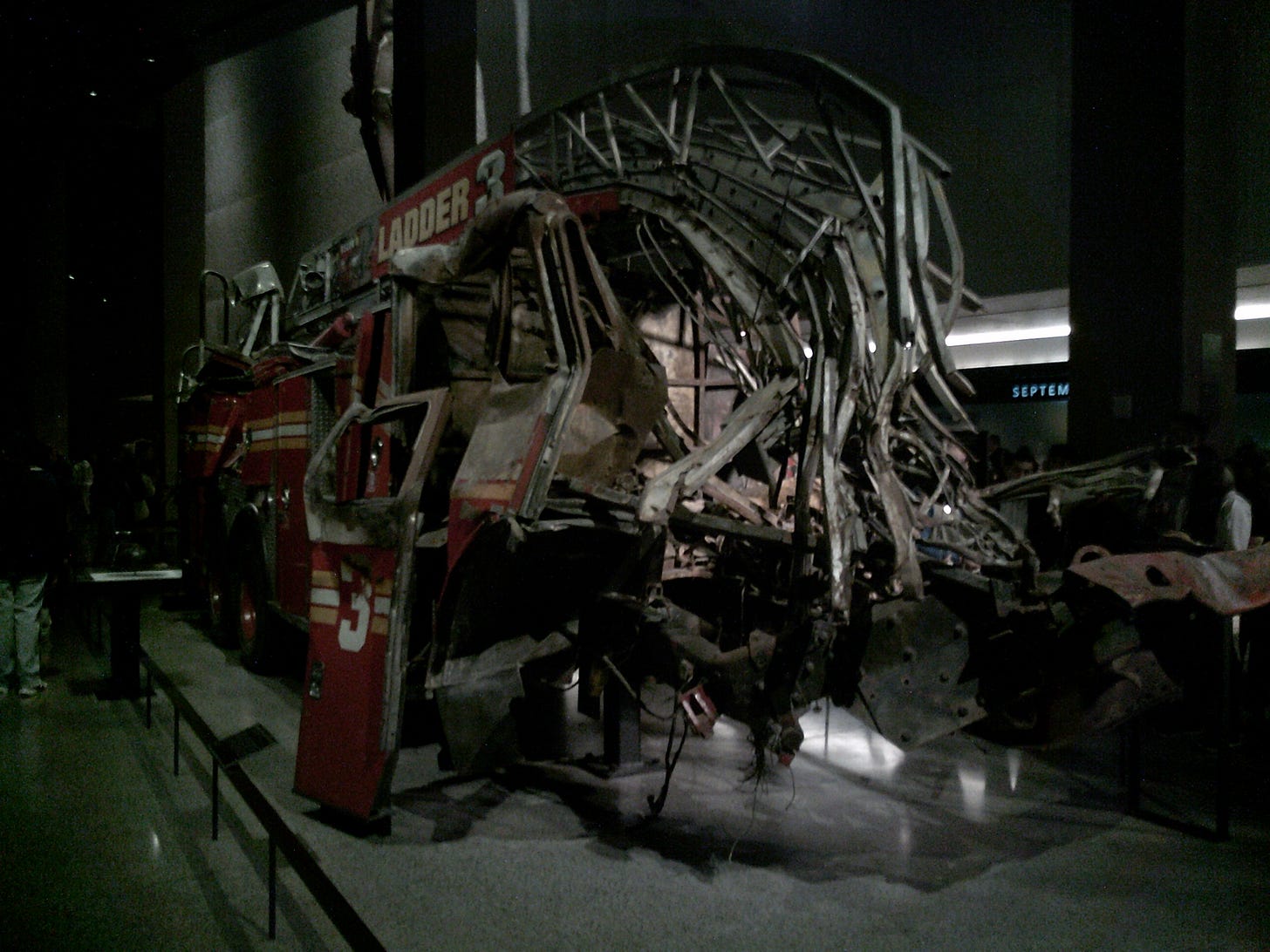
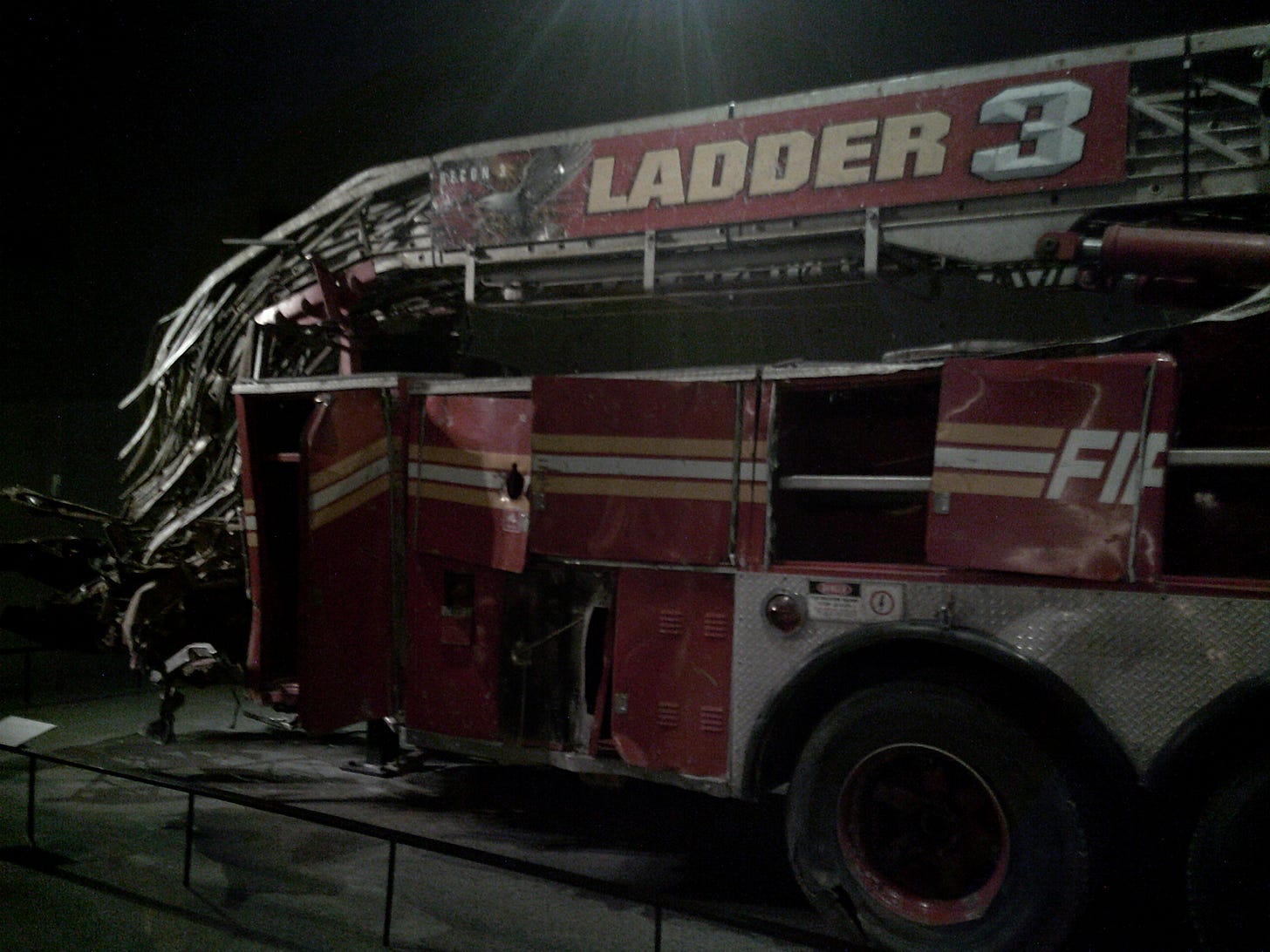

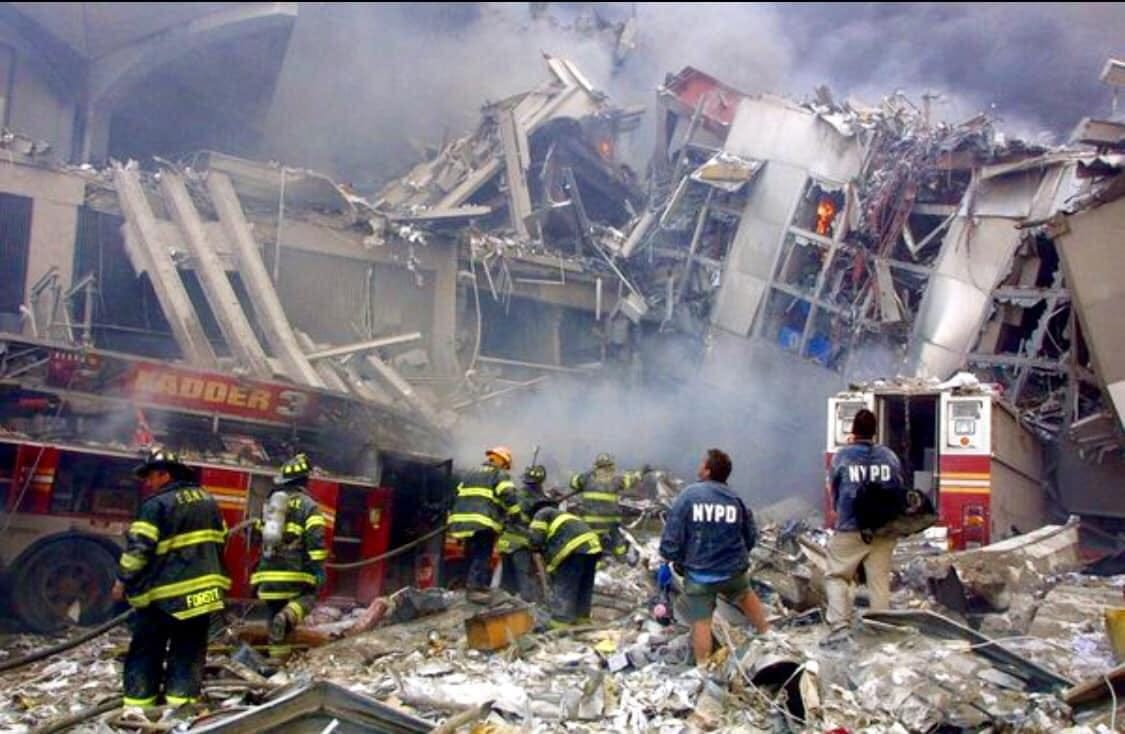



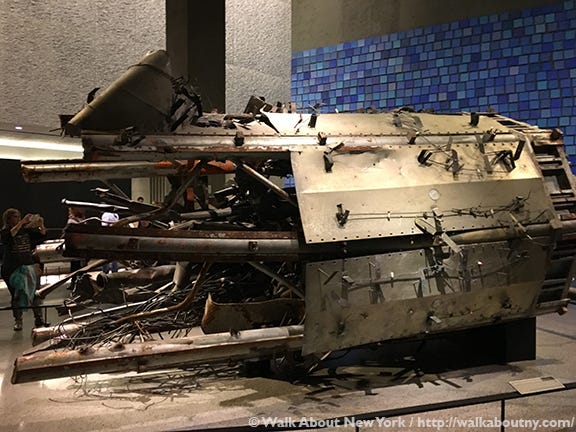
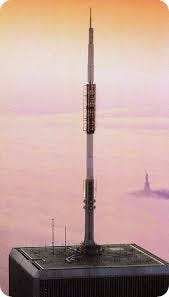



erasing history is the purpose, to embed lies as truth into whatever trace it left of reality
Reading part 1, where you described the giant tridents poking up from below, and riding the escalator down in to the depths, I thought of Virgil's Aeneid, and Aeneas' journey into the underworld. Imagine my surprise to see the Memorial referencing Virgil! Architects take inspiration from many sources, but this seems very incongruous for the 911 Memorial.
In book VI of the Aeneid, the Sybil leads Aeneas through different abodes of the underworld. In Fitzgerald's translation, lines 777- 782, "Then Tartarus itself goes plunging down, In darkness twice as deep as heaven is high for eyes fixed on etherial Olympus. Here is Earth's ancient race, the brood of Titans, Hurled by the lightning down to roll forever in the abyss. Lines 841-845 the Sybil says "Be on your way, and carry out your mission. Let us go faster. I can see the walls The Cyclops' forges built and, facing us, The portico and gate where they command us to leave the gifts required."
The battles between the Titans and Olympians were legendary, this link provides a short summary. https://ancient-literature.com/titans-vs-olympians/
Curiously, in recent years, revisionist historians have found unexplained gaps in the historical narrative of the 18th century, and written some extensive material on a lost civilization named Tartaria. Current readers may have read of the mud floods inundating cities and the lower floors of old buildings. It's an odd connection, Tartarus and Tartaria.
Virgil wrote the Aeneid between 29-19 BCE. The Roman Republic ended in 27 BCE, succeeded by the empire. It seems to me that our system of law was irreversibly changed post 911 with the passage of the Patriot Act , and we have certainly been watching an empire in our own time, not a republic.